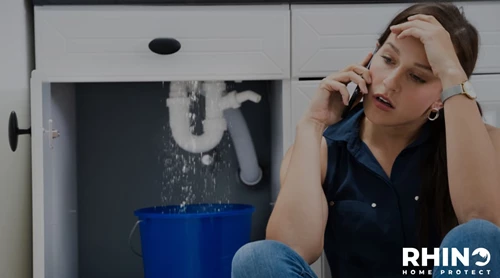How to deal with emergencies at your rental property
Imagine receiving an urgent call late at night from your tenant. Their panicked voice reveals a burst pipe rapidly turning their living room into a water feature. As a landlord, these scenarios can send shivers down your spine.
Navigating the unpredictable waters of property management, the question isn't if but when an emergency will strike. "How to deal with emergencies at your rental property" becomes more than a guide; it's an essential tool in the arsenal of every landlord.
Alongside these strategies, a robust home insurance policy stands as a bulwark against such disasters, shielding both your financial interests and your peace of mind. In this comprehensive exploration, we provide steps and insights to help you face unforeseen challenges, ensuring the safety and well-being of your tenants whilst safeguarding your investment.
Identifying Common Rental Property Emergencies
Emergencies have an uncanny way of appearing when least expected, leaving landlords and tenants alike vulnerable. To mitigate the impact of these crises, you should recognise the common types of rental property emergencies and take preemptive actions. Here's a breakdown of the most frequent emergencies and the measures you can adopt:
1. Fires:
- Install smoke detectors and fire extinguishers.
- Educate tenants about evacuation procedures.
2. Floods:
- Regularly inspect and maintain plumbing systems.
- Install flood alarms and encourage prompt leak reporting.
3. Gas Leaks
- Educate tenants about recognising the smell of gas.
- Provide clear instructions on shutting off the gas supply.
- Regularly inspect gas lines and appliances.
4. Electrical Faults:
- Schedule regular electrical inspections.
- Educate tenants about safe electrical practices.
- Install safety devices like residual current devices (RCDs).
5. Break-ins:
- Enhance security with robust locks.
- Reinforce entry points.
- Maintain communication with vigilant neighbours.
Conducting Risk Assessment and Prevention Measures
Preparation is the cornerstone of effective emergency management. You can significantly reduce the likelihood of emergencies by conducting a thorough risk assessment and implementing preventive measures. Here's how to get started:
Risk Assessment:
- Property Analysis: Evaluate the property's location, surroundings, and potential vulnerabilities.
- Weather Considerations: Consider weather patterns that could lead to floods or storms.
- Neighbourhood Evaluation: Assess the area's safety and security to identify potential risks.
Prevention Measures:
- Maintenance Schedules: Implement regular maintenance schedules for plumbing, electrical, and appliances.
- Weather-Proofing: Weather-proof the property by sealing windows, roofs, and entry points.
- Emergency Kits: Provide tenants with emergency kits containing essentials like flashlights, first aid supplies, and emergency contact lists.
Creating an Emergency Response Plan
A well-structured emergency response plan is your blueprint for handling crises. Follow these steps to develop an effective strategy:
- Identify Risks: Consider various emergency scenarios affecting your property, such as fires, floods, or break-ins.
- Assess Property Layout: Familiarise yourself with the property layout to determine escape routes and safe areas.
- Emergency Contacts: Compile a list of emergency contacts, including local authorities, repair services, and utility companies.
- Tenant Information: Gather contact details for all tenants and establish a method to reach them quickly.
- Communication Plan: Develop a clear communication strategy, including how to notify tenants during emergencies.
- Evacuation Procedures: Outline evacuation procedures for different scenarios and ensure tenants know them.
- Emergency Kit: Create a well-equipped emergency kit with essential supplies for tenants and the property.
- Regular Review: Review and update the plan regularly to account for changes in property layout, tenant information, or emergency contacts.
Clear and effective communication with your tenants is essential for handling emergencies smoothly. Providing them with emergency contact information and educating them on the steps to take during crises can significantly improve their safety and minimise property damage.
Encourage an open line of communication where tenants feel comfortable reporting potential hazards or emergencies promptly. Regularly reminding tenants about emergency procedures and the importance of prompt communication can create a sense of responsibility and preparedness within the community.
Building a Relationship with Tenants for Emergency Situations
Fostering a solid tenant relationship holds paramount importance for successful emergency management. Consistent communication serves as the cornerstone for efficient emergency response. This includes providing tenants with routine updates on emergency protocols and imparting knowledge about preventive actions, like shutting off water supplies before extended absences.
Furthermore, engaging tenants in emergency planning conversations is vital, allowing their insights and perspectives to shape customised plans that cater to their specific requirements.
Emergency Contact List Development
Having an easily accessible and well-organised emergency contact list becomes your lifeline, facilitating swift and effective response. Such a list is a critical tool that ensures the right professionals are reached promptly when crises arise. This comprehensive compilation includes essential contacts that play a pivotal role in safeguarding your property and the well-being of your tenants. Some of the key entities to have are:
- Local Authorities: Include the contact details for the local police department, fire brigade, and medical services. These professionals are trained to address various emergencies and can offer immediate assistance when required.
- Repair Services: Incorporate the contact information of trusted contractors specialising in plumbing, electrical work, and other urgent repairs. Timely access to these experts can mitigate damage and help restore the property's functionality swiftly.
Insurance Considerations for Rental Property Emergencies
Home insurance is a reliable lifeline, ready to provide financial protection and much-needed peace of mind during emergencies.
Home Sellers and Home Buyers Insurance
The protective umbrella of insurance extends to both home sellers and buyers, ensuring that unforeseen rental property emergencies don't translate into financial turmoil. Having comprehensive insurance coverage becomes paramount, enabling you to navigate crises with the reassurance that you're shielded from potential financial burdens.
Emergency Coverage Features
Delving into insurance policies uncovers valuable features designed to alleviate the impact of emergencies. One such feature to prioritise is temporary accommodation coverage for tenants in times of crisis. This provision ensures that should a rental property become uninhabitable due to an emergency, your insurance can help cover the cost of accommodating tenants elsewhere while repairs are underway.
Emergency Repair and Maintenance Strategies
In emergencies, swift action is paramount. Here's how to manage repairs efficiently:
- Immediate Response: Have a list of contractors on standby for urgent repairs, ensuring you can address issues promptly.
- Reputable Repair Services: Research and collaborate with reputable repair services to ensure quality workmanship.
Legal Obligations for Landlords in Emergencies
As a landlord, being well-versed in your legal obligations is a cornerstone of responsible property management. This knowledge becomes even more critical in emergency situations, where adherence to regulations ensures your tenants' safety and protects your legal standing. Here's a look at what you need to do to ensure compliance with local regulations in the UK and uphold your responsibilities during emergencies:
Compliance with Local Regulations:
- Gas Safety Regulations: Regular gas safety checks by a registered engineer are mandatory. An annual gas safety certificate must be provided to tenants.
- Electrical Safety Standards: Ensure that electrical systems and appliances are safe and regularly inspected by qualified professionals.
- Fire Safety Regulations: Uphold fire safety measures, including providing working smoke alarms and carbon monoxide detectors and conducting fire risk assessments for properties with communal areas.
- Tenant Deposit Protection: Register tenant deposits with a government-approved scheme and provide necessary information to tenants.
- Housing Health and Safety Rating System (HHSRS): Conduct risk assessments to identify potential hazards affecting your tenants' health and safety.
- Right to Rent Checks: Confirm the immigration status of your tenants to ensure they have the right to rent property in the UK.
By understanding and adhering to these local regulations, you create a secure environment for your tenants and mitigate the risk of legal complications during emergencies.
Emergencies demand a collective effort. Both home sellers and buyers should understand that effective emergency preparedness is crucial for the well-being of tenants and the protection of property investments.
You can confidently navigate the unexpected and uphold your responsibilities as a landlord through open communication, establishing protocols, and staying informed about insurance options and legal obligations.
Within the intricate realm of rental property management, the unexpected is bound to occur, yet financial setbacks needn't be a given.
For both home sellers and buyers, bolstering your assets with appropriate insurance is not merely wise—it's imperative.
With tailored coverages aptly addressing landlords' concerns, your prime focus can remain on the paramount: the safety and welfare of your tenants. Reach out to Rhino Home Protect now and embark on a more assured path for your rental venture.



